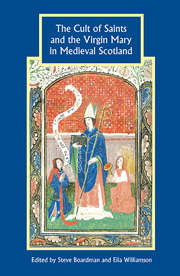Book contents
- Frontmatter
- Contents
- List of Illustrations and Tables
- List of Contributors
- Abbreviations
- Introduction
- 1 The Big Man, the Footsteps, and the Fissile Saint: paradigms and problems in studies of insular saints' cults
- 2 St Munnu in Ireland and Scotland: an exploration of his cult
- 3 The struggle for sanctity: St Waltheof of Melrose, Cistercian in-house cults and canonisation procedure at the turn of the thirteenth century
- 4 Royal and aristocratic attitudes to saints and the Virgin Mary in twelfth- and thirteenth-century Scotland
- 5 A saintly sinner? The ‘martyrdom’ of David, duke of Rothesay
- 6 Wo/men only? Marian devotion in medieval Perth
- 7 Is eagal liom lá na hagra: devotion to the Virgin in the later medieval Gàidhealtachd
- 8 Scottish saints' legends in the Aberdeen Breviary
- 9 Mothers and their sons: Mary and Jesus in Scotland, 1450–1560
- 10 The ‘McRoberts thesis’ and patterns of sanctity in late medieval Scotland
- Index
10 - The ‘McRoberts thesis’ and patterns of sanctity in late medieval Scotland
Published online by Cambridge University Press: 05 October 2013
- Frontmatter
- Contents
- List of Illustrations and Tables
- List of Contributors
- Abbreviations
- Introduction
- 1 The Big Man, the Footsteps, and the Fissile Saint: paradigms and problems in studies of insular saints' cults
- 2 St Munnu in Ireland and Scotland: an exploration of his cult
- 3 The struggle for sanctity: St Waltheof of Melrose, Cistercian in-house cults and canonisation procedure at the turn of the thirteenth century
- 4 Royal and aristocratic attitudes to saints and the Virgin Mary in twelfth- and thirteenth-century Scotland
- 5 A saintly sinner? The ‘martyrdom’ of David, duke of Rothesay
- 6 Wo/men only? Marian devotion in medieval Perth
- 7 Is eagal liom lá na hagra: devotion to the Virgin in the later medieval Gàidhealtachd
- 8 Scottish saints' legends in the Aberdeen Breviary
- 9 Mothers and their sons: Mary and Jesus in Scotland, 1450–1560
- 10 The ‘McRoberts thesis’ and patterns of sanctity in late medieval Scotland
- Index
Summary
In 1968 The Innes Review published an article by David McRoberts which was (to use a word often overused in recent years) seminal. Its influence is visible in much, indeed in almost everything, that has been written since 1968 about the Church and about religion in later medieval Scotland. The thesis which it presented was relatively straightforward. McRoberts argued that the fifteenth century witnessed a new and what he called ‘nationalist’ trend in Scottish religious observation. There were several dimensions to this development – but it was especially apparent, McRoberts argued, in the veneration of saints. Before the fifteenth century the Church had neglected Scotland's early saints; thereafter leading clergymen began to look anew at these forgotten worthies. In the earlier part of the century Prior James Haldenstone of St Andrews had coordinated a campaign to have St Duthac officially canonised. Elsewhere there were efforts to relocate the relics and to promote the cults of St Kentigern (at Glasgow and Culross), St Ninian (at Whithorn) and St Triduana (at Restalrig). We find the chronicler Walter Bower lauding St Columba and Archbishop Schevez of St Andrews mounting a search for the relics of St Palladius. This ‘devotional nationalism’ reached its culmination, according to McRoberts, in the early sixteenth century with the work of Bishop William Elphinstone and a team of collaborators in Old Aberdeen, who produced a new martyrology and a new breviary.
- Type
- Chapter
- Information
- The Cult of Saints and the Virgin Mary in Medieval Scotland , pp. 177 - 194Publisher: Boydell & BrewerPrint publication year: 2010



